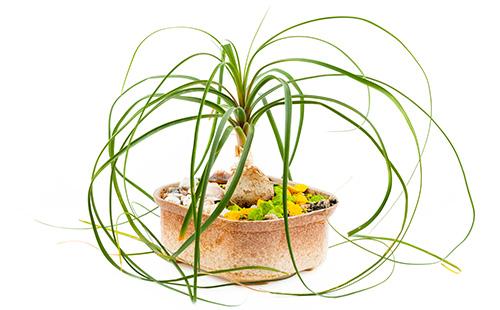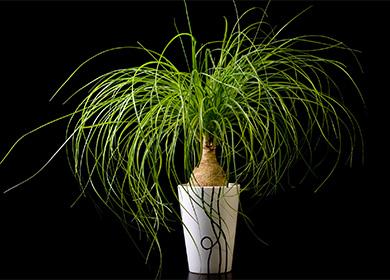The content of the article
At the first glance at the plant, the origin of the popular names becomes clear - “elephant leg”, “bottle tree”, “horse tail”. A bare trunk with a peculiar thickening is crowned with a cap of thin long leaves. Bokarney - a stylish solution for the modern interior of the apartment.
Botanical Description
The most common folk name for nolin - “bottle tree” - is associated with the unusual shape of its trunk. In nature, perennial succulents grow in areas where periods of drought often occur. Due to unfavorable growing conditions, the scorpion has learned to make moisture reserves in the bulk thickening of the trunk - caudex. One or more thinner lignified trunks depart from the caudex. Cracking bark, thin, gray or light brown.
Long, thin leaves are collected at the apex, which gives a more palmar resemblance to a palm tree. In adult specimens, they grow to a meter. The foliage is stiff, with protruding veins. Gradually, the lower leaves of the nolin die off, replaced by new ones. In nature, nolin blooms at the age of 15–20 years. Paniculate inflorescences, flowers are yellowish-white, with a pronounced pleasant smell. In apartments, nolin does not bloom.
The genus consists of approximately 30 species, but only a few are grown in room culture. The most common is nolin (bokarneya) bent. The variety is distinguished by pronounced caudex - in nature it reaches a meter diameter. Slightly less common is a squeezed sidebar with a more squat and rounded trunk. The rarest species in home collections is nolina Lindemeira. This is a large succulent, reaching human growth. Leaves curiously twist, forming a "curly" crown.
Nolina care: what to consider
Nolina is a relatively unpretentious plant. But due to inappropriate conditions of detention, sometimes problems arise: it becomes less pronounced or rotes the caudex, the foliage dries. How to care for a nolin flower so that this does not happen? Experienced flower growers recommend that you adhere to the following rules.
- Lighting. Medium-sized specimens are kept on windowsills of windows facing west or east in summer, shade from the sun at noon. Large "palm trees" are placed next to the window so that the plant receives enough light.
- Temperature. During the period of active growth, nolin adapts to the indoor microclimate, does not need to create special temperature conditions. In winter, a forced rest period is arranged, gradually lowering the temperature to 10 ° C. At any time of the year, exposure to drafts is avoided. If it is not possible to provide a cold wintering, create a full-fledged lighting using phytolamps.
- Watering. In the warm season, you need to water nolina abundantly.Prefer lower watering through a pan or immerse the pot in water. When the earth is completely saturated, excess water is allowed to drain, the succulent is returned to its original place. Between watering, they dry the land well. The frequency of watering in winter depends on the conditions of detention. During a warm winter, water in the same mode. At 15 ° C, watering is limited, below 10 ° C - they stop.
- Humidity. Nolina grows well in dry air. But in hot weather, the leaves are sprayed with warm, soft water. It is useful to wipe the foliage with a damp cloth or sponge.
- Top dressing. Bokarneya has been growing rapidly for the first six to seven years since planting. To stimulate growth, liquid mineral fertilizers are applied every three weeks in a reduced dosage. For adult plants, the frequency of top dressing is reduced. Fertilizers are applied to moist soil. Do not abuse nitrogen - from its excess leaves lose their stiffness. Occasionally, you can feed a weak solution of organic fertilizer.
- The soil. Ready mixes for succulents are suitable. At home, the substrate is obtained by mixing deciduous land, peat and sand. The main requirement is friability and water permeability.
- Transfer. It is carried out as necessary when the roots are covered with an earthen lump. Young specimens cross every spring, adults in about three to four years. Pots are used slightly cramped, up to a third of the volume is filled with drainage material. The planting depth is left unchanged - the bulb (caudex) should remain completely above the surface. The first three to four days after planting are not watered.
Breeding methods
Nolina is considered difficult to breed succulent. The main method is growing from seeds, as it gives lateral shoots very rarely. Both methods take time and a serious approach.
Seeds
Nolina from seeds at home will grow for a very long time. But sometimes this is the only way to grow a beauty with a goblet. Landing is carried out in the following sequence.
- Seed preparation. The seeds are kept for 24 hours in a weak solution of the growth stimulator Zircon or Epin.
- Sowing. Prepare a substrate of peat and sand, fill it with a container, moisturize. Distribute seeds, cover with a thin layer of soil.
- Germination conditions. The container is covered with a film, put under a phytolamp. The temperature is maintained at the level of 21–25 ° C. Often check the condition of the soil - it should be slightly moist. The film is removed daily, the condensate formed is removed. Shoots appear after three to four weeks.
- Pick. Strong, grown seedlings are planted in individual pots.

Scions
Reproduction of nolin by the lateral processes is a simpler, but not always possible way. Bokarney rarely gives them. If an shoot has appeared on the main trunk, which can be separated without prejudice to the mother plant, they act in the following sequence.
- Training. The process is carefully separated from the trunk by hand. The place of damage is sprinkled with carbon powder.
- Landing. Fill the landing tank with a substrate of sand, peat and vermiculite, water it a little. The shoot is planted, compact the earth around.
- Care. The process is covered with a jar, placed in a bright, warm place.Until the roots appear, the temperature is maintained at 21–26 ° C. Periodically water the earth with the addition of a small amount of rooting agent. The ground part of the process is sprayed with Zircon solution. The greenhouse is often ventilated, the accumulated condensate is removed. After the appearance of new leaves, the jar is removed.
Frequent florist errors
Bokarneya is a naturally strong plant that can withstand adverse weather conditions. The only thing that can cause her serious harm is the wrong watering regime. What other difficulties do gardeners have to face? The most common errors can be found in the table.
Table - Common floriculture errors
| Description of the problem | Possible reasons | Help the plant |
|---|---|---|
| The nolins dry the tips of the leaves | Dry air | - Clean nolin away from heaters: - spray the crown, preventing moisture from entering the trunk |
| Leaves are small, poorly developed | - Lack of nutrition; - prolonged lack of transplantation | - Transplanted into a more spacious pot; - every three to four weeks they feed |
| Exfoliates bark, softens the trunk | - Waterlogging of the soil; - rotting of the roots; - dense soil | - Affected areas are cut to living tissue; - transplanted into loose soil; - reduce watering; –Spray with “Zircon” |
| The trunk stretches, the leaves look lethargic | - The combination of plentiful watering and lack of light | - Completely dry the soil; - rearranged in a well-lit place |
| Leaves fall and turn yellow (lower) | The natural process of dying off old leaves | Do nothing |
| The trunk frowns, loses its shape | - The prolonged wintering; - prolonged lack of watering | - Gradually increase the intensity of irrigation; - regularly fed |

Diseases and Pests
The only disease of nolin is rot of horses and caudex. More often it develops due to abundant watering, less often you have to deal with fungal rot. The initial stage of the disease is diagnosed by lethargy of leaves, softening of caudex.
Bokarney immediately transplanted with pruning damaged roots, treatment with fungicides and disinfectants. For a while, nolin is left without watering - there is enough moisture in the caudex to prevent the plant from dying. Pests are not particularly dangerous, but sometimes you have to deal with shields, spider mites and thrips. Details of these pests are given in the table.
Table - Bokarney Pests
| Pest | Signs of defeat | Ways to fight |
|---|---|---|
| Thrips | - Silver streaks appear; - leaves are deformed; - overall growth slows down | - Processed with any insecticide; - cover for several hours with a plastic bag |
| Shields | - Hard brown plaques appear on the underside of the leaves; - leaves turn yellow, become sticky | - Remove insects manually; - sprayed with Fitoverm several times until the pests completely disappear |
| Spider mite | - The leaves are covered with yellow dots, which gradually turn into large spots; - the crown is covered with a thin web | - Sprayed with "Actara"; - apply an ultraviolet lamp; - increase humidity |
Caring for a scorpion at home requires observing the watering regime. The rest of the flower is relatively unpretentious - it easily tolerates drought and low humidity.Bokarneya is suitable even for busy people, often traveling.

